List of Japanese flags
This is a list of Japanese flags, past and present. Historically, each daimyō had his own flag. (See sashimono and uma-jirushi.)
National flags
[edit]| Flag | Date | Use | Description |
|---|---|---|---|
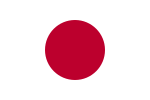 |
13 August 1999 – present | Civil and state flag and ensign of Japan. | Flag ratio: 2:3. This flag was designated by Proclamation No. 127, 1999. The sun-disc is perfectly centered and is a brighter shade of red. |
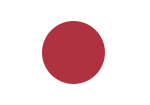 |
27 February 1870 – 12 August 1999 | Civil and state flag and ensign of the Empire of Japan, and the Japanese state. | Flag ratio: 7:10. Disc is shifted 1% towards the hoist (left). This flag was designated by Proclamation No. 57, 1870. |
Imperial flags
[edit]| Flag | Date | Use | Description |
|---|---|---|---|
 |
1869–present | Imperial standard of the emperor of Japan | A gold 16 petal chrysanthemum centered on a red background |
 |
2019–present | Imperial standard of the emperor emeritus | Similar to the standard of the emperor, but with a darker background |
 |
1926–present | Imperial standard of the empress, the Empress dowager, the grand empress dowager and the empress emerita | A pennant of the standard of the emperor |
 |
1926–present | Imperial standard of the regent of Japan | Similar to the standard of the emperor, but with a white border |
 |
1926–present | Imperial standard of the heir imperial son and the imperial grandson who is an heir apparent | Similar to the standard of the emperor, but with a white orle |
 |
1926–present | Imperial standard of the wife of the heir imperial son and the wife of the imperial grandson | A pennant of the standard of the heir imperial son |
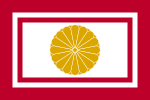 |
2020–present | Imperial standard of the crown prince if not the son of the emperor | A gold 16-petaled chrysanthemum centered on a white background with a red orle and border |
 |
1926–present | Imperial standard of other members of the Imperial House | Similar to the standard of the crown prince, but without the red orle |
Governmental flags
[edit]| Flag | Date | Use | Description |
|---|---|---|---|
 |
1872–1887 | Ensign of Japan Post | Hinomaru with a red horizontal bar placed in the center of the flag. |
 |
1892–present | Ensign of Japan Customs | White represents land, blue represents sea, and the red disc represents the customs on a border. |
Military flags
[edit]Self-Defense Force and Imperial Army/Navy
[edit]| Flag | Date | Use | Description |
|---|---|---|---|
 |
1954–present | Flag of the Japan Self-Defense Forces and the Japan Ground Self-Defense Force | A sun disc design with 8 red rays extending outward, and a gold border partially around the edge. |
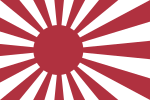 |
1889–1945 | Ensign of the Imperial Japanese Navy | Sun disc with 16 rays on a white field, with the disc skewed to the hoist. |
 |
1945–present | Ensign of the Japan Maritime Self-Defense Force | Sun disc with 16 rays on a white field, with the disc skewed to the hoist. |
 |
1955–1957 | Former ensign of the Japan Air Self-Defense Force | Used from 1955 to 1957. |
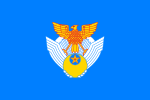 |
1957–1972 | Former ensign of the Japan Air Self-Defense Force | Used from 1957 to 1972. |
 |
1972–2001 | Former ensign of the Japan Air Self-Defense Force | Used from 1972 to 2001. |
 |
2001–present | Ensign of the Japan Air Self-Defense Force | Current ensign, used since 2001. |
 |
1972–present | Standard of the prime minister of Japan | Five cherry blossoms on a purple background. |
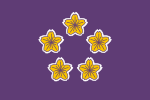 |
1972–present | Naval standard of the prime minister of Japan | Five cherry blossoms on a purple background. |
 |
1972–present | Standard of the minister of defense of Japan | Five cherry blossoms on a magenta background. |
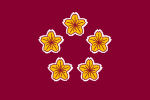 |
1972–present | Naval standard of the minister of defense of Japan | Five cherry blossoms on a magenta background. |
 |
1972–present | Standard of the vice minister of defense of Japan | Four cherry blossoms on a magenta background. |
 |
1972–present | Naval standard of the vice minister of defense of Japan | Four cherry blossoms on a magenta background. |
 |
Standard of Chief of Staff, Joint Staff | ||
 |
Standard of Chief of Staff of the Japan Ground Self-Defense Force | ||
 |
Standard of Chief of Staff of the Japan Maritime Self-Defense Force | ||
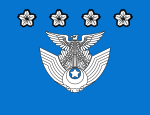 |
1982– | Standard of Chief of Staff of the Japan Air Self-Defense Force | |
 |
1965– | Standard of vice admiral of the Japan Maritime Self-Defense Force | |
 |
1965– | Standard of rear admiral of the Japan Maritime Self-Defense Force | |
 |
1965– | Standard of commodore of the Japan Maritime Self-Defense Force | |
 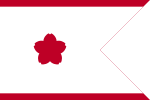 |
1965– | Standards of commander of the Japan Maritime Self-Defense Force | |
 |
1965– | Standard of senior captain of the Japan Maritime Self-Defense Force | |
| 1954– | Masthead pennant of the Japan Maritime Self-Defense Force | ||
 |
1905–1945, 2011– | The "Z flag", unofficial naval ensign | Derived from International maritime signal flag "Z" Made famous by its use to signal the opening of the Battle of Tsushima. |
 |
Flag of composite forces chief of staff of the Japan Ground Self-Defense Force | ||
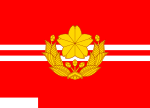 |
1972– | Flag of infantry battalion group of the Japan Ground Self-Defense Force | |
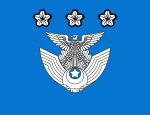 |
1982– | Flag of air defense command of the Japan Air Self-Defense Force | |
 |
1980– | Flag of the Japan Ground Self-Defense Force reserve | |
 |
1870–1945 | War flag of the Imperial Japanese Army | Centered sun disc with 16 rays on a white field. |
 |
1889–1945 | Standard of admiral of the Imperial Japanese Navy | |
 |
1914–1945 | Standard of vice admiral of the Imperial Japanese Navy | |
 |
1914–1945 | Standard of rear admiral of the Imperial Japanese Navy | |
 |
1914–1945 | Standard of commodore of the Imperial Japanese Navy | |
 |
1914–1945 | Standard of commander of the Imperial Japanese Navy | |
 |
1914–1945 | Standard of senior captain of the Imperial Japanese Navy | |
 |
1870–1945 | Standard of duty ship of the Imperial Japanese Navy |
Japan Coast Guard
[edit]| Flag | Date | Use | Description |
|---|---|---|---|
 |
1951– | Ensign of the Japan Coast Guard | The symbol represents a mariner's compass. |
 |
1951– | Standard of the minister of land, infrastructure, transport and tourism | |
 |
1951– | Standard of the Japan Coast Guard commandant | |
 |
1951– | Standard of the commander of Regional Coast Guard Headquarters | |
 |
1951– | Flag of the commander |
Historical flags
[edit]| 13th–19th century | Military Flag of the warriors loyal to Japanese court. | A red field with a golden disc in the center and 3 sestiere on the fly. | |
 |
1429–1879 | Merchant Flag of the Ryukyu Kingdom. | A triangular yellow field with a red border and a red disc in the center. |
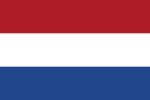 |
1641–1854 | Flag used in Dejima | A horizontal tricolor of red, white and blue. |
 |
1603–1868 | Naval ensign of the Tokugawa Shogunate.[1] | A bicolour flag consisting of three bands; white, black, and white. |
 |
1668–1869 | Flag used by the Satsuma army during the Boshin War | A horizontal bicolour of red and white. |
 |
1905–1910 | Flag of the Resident General of Korea. | A blue ensign with the Flag of Japan in the canton. |
 |
1945–1952 | Civil and naval ensign during the occupation of Japan. | Derived from International maritime signal flag "E". |
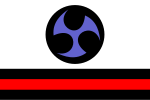 |
1797[2]–1879 | Flag of the Ryukyu Kingdom. | Features a mitsudomoe, the symbol of the ruling Second Shō dynasty. |
 |
1950 (Jan–Mar) | Proposed flag of Okinawa. | Called the Okinawan Flag (沖縄旗) or the Ryukyu Flag (琉球旗), proposed by the Okinawa Civil Government. The US administration stated they would decide the flag after the foundation of the unified government of the islands. However, the flag was forgotten ever since. Red, white, and blue represent peace, freedom, and enthusiasm, respectively. A star represents hope. |
 |
1952–1967 | Civil ensign during the occupation of Okinawa. | Derived from International maritime signal flag "D". |
 |
1967–1972 | Civil ensign of the Government of the Ryukyu Islands. | Ryukyus pennant above Japanese flag was used during U.S. occupation of Ryukyu Islands. |
Daimyō Flags
[edit]Flags attributed to Japanese Daimyo in the Kaei period (1848-54).
-
Arima clan of Kurume Domain (A)
-
Arima clan of Kurume Domain (B)
-
Arima clan of Kurume Domain (C)
-
Asano clan of Hiroshima Domain (A)
-
Asano clan of Hiroshima Domain (B)
-
Asano clan of Hiroshima Domain (C)
-
Date clan of Uwajima Domain (A)
-
Date clan of Uwajima Domain (B)
-
Date clan of Uwajima Domain (C)
-
Date clan of Sendai Domain (A)
-
Date clan of Sendai Domain (B)
-
Date clan of Sendai Domain (C)
-
Hachisuka clan of Tokushima Domain (A)
-
Hachisuka clan of Tokushima Domain (B)
-
Hachisuka clan of Tokushima Domain (C)
-
Hosokawa clan of Kumamoto Domain (A)
-
Hosokawa clan of Kumamoto Domain (B)
-
Hosokawa clan of Kumamoto Domain (C)
-
Ii clan of Hikone Domain (A)
-
Ii clan of Hikone Domain (B)
-
Ii clan of Hikone Domain (C)
-
Ikeda clan of Okayama Domain (A)
-
Ikeda clan of Okayama Domain (B)
-
Ikeda clan of Okayama Domain (C)
-
Ikeda clan of Tottori Domain (A)
-
Ikeda clan of Tottori Domain (B)
-
Ikeda clan of Tottori Domain (C)
-
Kuroda clan of Fukuoka Domain (A)
-
Kuroda clan of Fukuoka Domain (B)
-
Kuroda clan of Fukuoka Domain (C)
-
Makino clan of Nagaoka Domain (A)
-
Makino clan of Nagaoka Domain (B)
-
Makino clan of Nagaoka Domain (C)
-
Maeda clan of Kaga Domain (A)
-
Maeda clan of Kaga Domain (B)
-
Maeda clan of Kaga Domain (C)
-
Matsudaira clan of Fukui Domain (A)
-
Matsudaira clan of Fukui Domain (B)
-
Matsudaira clan of Fukui Domain (C)
-
Matsudaira clan of Kuwana Domain (A)
-
Matsudaira clan of Kuwana Domain (B)
-
Matsudaira clan of Kuwana Domain (C)
-
Mōri clan of Chōshū Domain (A)
-
Mōri clan of Chōshū Domain (B)
-
Mōri clan of Chōshū Domain (C)
-
Nabeshima clan of Saga Domain (A)
-
Nabeshima clan of Saga Domain (B)
-
Nabeshima clan of Saga Domain (C)
-
Nanbu clan of Morioka Domain (A)
-
Nanbu clan of Morioka Domain (B)
-
Nanbu clan of Morioka Domain (C)
-
Ogasawara clan of Kokura Domain (A)
-
Ogasawara clan of Kokura Domain (B)
-
Ogasawara clan of Kokura Domain (C)
-
Ōmura clan of Omura Domain (A)
-
Ōmura clan of Omura Domain (B)
-
Ōmura clan of Omura Domain (C)
-
Satake clan of Kubota Domain (A)
-
Satake clan of Kubota Domain (B)
-
Satake clan of Kubota Domain (C)
-
Shimazu clan of Satsuma Domain (A)
-
Shimazu clan of Satsuma Domain (B)
-
Shimazu clan of Satsuma Domain (C)
-
Tōdō clan of Tsu Domain (A)
-
Tōdō clan of Tsu Domain (B)
-
Tōdō clan of Tsu Domain (C)
-
Tokugawa clan of Kishū Domain (A)
-
Tokugawa clan of Kishū Domain (B)
-
Tokugawa clan of Kishū Domain (C)
-
Tokugawa clan of Mito Domain (A)
-
Tokugawa clan of Mito Domain (B)
-
Tokugawa clan of Mito Domain (C)
-
Tokugawa clan of Owari Domain (A)
-
Tokugawa clan of Owari Domain (B)
-
Tokugawa clan of Owari Domain (C)
-
Uesugi clan of Yonezawa Domain (A)
-
Uesugi clan of Yonezawa Domain (B)
-
Uesugi clan of Yonezawa Domain (C)
-
Yamauchi clan of Tosa Domain (A)
-
Yamauchi clan of Tosa Domain (B)
-
Yamauchi clan of Tosa Domain (C)
Daimyō Banners present in old paintings
[edit]-
Arima Noriyari
-
Arima Toyōji
-
Arima Toyōji
-
Hayashi Katsumasa
-
Honda Masatomo
-
Hori Naoyori
-
Inoue Masatsugu
-
Katō Akinari
-
Kuroda Tadayuki
-
Kuroda Tadayuki
-
Makino Narizumi
-
Matsudaira Tadakatsu
-
Matsudaira Chikatoki
-
Matsudaira Mitsunaga
-
Matsudaira Naomasa
-
Matsudaira Naonori
-
Matsudaira Shigenao
-
Matsudaira Tadaaki
-
Matsudaira Tadaaki
-
Matsudaira Terusada
-
Mizuno Katsunari
-
Mizuno Katsunari
-
Mori Nagatsugu
-
Nabeshima Tadanao
-
Nabeshima Tadanao
-
Ogasawara Nagatsugu
-
Okudaira Iemasa
-
Okudaira Iemasa
-
Ōtani Yoshitsugu
-
Sakai Ietsugu
-
Sakai Ietsugu
-
Sakikibara Motonao
-
Shimazu Mitsuhisa
-
Tachibana Tadashige
-
Terazawa Katataka
-
Toda Ujinobu
-
Uesugi Mochifusa
Minorities
[edit]| Flag | Date | Use | Description |
|---|---|---|---|
 |
(1996) 1994–[citation needed] | Flag of Mindan | Flag of Mindan, a pro-South organization of Zainichi Koreans. The pink flower surrounding the taegeuk is a hibiscus syriacus, the national flower of South Korea. The formal name of the society (Zainihon Daikanminkoku Mindan) is written in kanji in white, and the abbreviation (Mindan) is written in hangul in yellow. The blue field of the flag stands for clear sky and sea. |
 |
1923–1945[citation needed] | Flag of National Levelers Association / Buraku Liberation League | Flag of National Levelers Association, a burakumin rights group, and Buraku Liberation League, NLA's succeeding group. Named the Crown of Thorns Flag (荊冠旗, Keikanki). Black represents a dark society with discriminations. Red represents blood. |
 |
1945–[citation needed] | Flag of Buraku Liberation League | The current Buraku Liberation League flag, with a white star representing hope. |
 |
1973–[citation needed] | Flag of Ainu | . |
Cultural flags
[edit]| Flag | Date | Use | Description |
|---|---|---|---|
 |
1919– | Flag of safety | Named the Green Cross (緑十字, Midori-jūji). Designed by Toshifumi Gamō as the symbol of the governmental "safety week" campaign. The cross represents philanthropism in Western sense, and the place where good deeds gather in Oriental sense. JIS Z9103-1986 designates the symbol as the safety indication sign. |
 |
1953– | Flag of industrial health | Announced by the Labour Standards Bureau, the Ministry of Labor of Japan (the current Ministry of Health, Labour and Welfare), over a public subscription. |
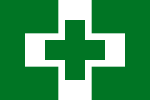 |
1965– | Flag of safety and health | Designed by the Japan Industrial Safety & Health Association. These three flags are frequently flown on factories or construction sites. |
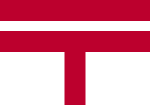 |
1887– | Postal flag | The Postal symbol, 〒, on a white field. |
Prefectural flags
[edit]Each modern prefecture has a unique flag, most often a bicolour geometric highly stylised design (mon), often incorporating the letters of Japanese writing system and resembling company logos. A distinct feature of these flags is that they use a palette of colours not usually found in flags, including orange, purple, aquamarine and brown.
Some prefectures also have alternative official flags called "symbol flags" (シンボル旗). They may be used on less formal occasions. Famous symbol flags include the one used in Tokyo.
| Flag | Prefecture | Geocode |
|---|---|---|
 |
Aichi | JP-23 |
 |
Akita | JP-05 |
 |
Aomori | JP-02 |
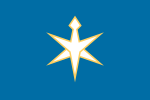 |
Chiba | JP-12 |
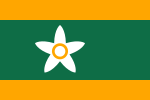 |
Ehime | JP-38 |
 |
Fukui | JP-18 |
 |
Fukuoka | JP-40 |
 |
Fukushima | JP-07 |
 |
Gifu | JP-21 |
 |
Gunma | JP-10 |
 |
Hiroshima | JP-34 |
 |
Hokkaido | JP-01 |
 |
Hyōgo | JP-28 |
 |
Ibaraki | JP-08 |
 |
Ishikawa | JP-17 |
 |
Iwate | JP-03 |
 |
Kagawa | JP-37 |
 |
Kagoshima | JP-46 |
 |
Kanagawa | JP-14 |
 |
Karafuto | N/A |
 |
Kōchi | JP-39 |
 |
Kumamoto | JP-43 |
 |
Kyoto | JP-26 |
 |
Mie | JP-24 |
 |
Miyagi | JP-04 |
 |
Miyazaki | JP-45 |
 |
Nagano | JP-20 |
 |
Nagasaki | JP-42 |
 |
Nara | JP-29 |
 |
Niigata | JP-15 |
 |
Ōita | JP-44 |
 |
Okayama | JP-33 |
 |
Okinawa | JP-47 |
 |
Ōsaka | JP-27 |
 |
Saga | JP-41 |
 |
Saitama | JP-11 |
 |
Shiga | JP-25 |
 |
Shimane | JP-32 |
 |
Shizuoka | JP-22 |
 |
Tochigi | JP-09 |
 |
Tokushima | JP-36 |
 |
Tokyo | JP-13 |

| ||
 |
Tottori | JP-31 |
 |
Toyama | JP-16 |
 |
Wakayama | JP-30 |
 |
Yamagata | JP-06 |
 |
Yamaguchi | JP-35 |
 |
Yamanashi | JP-19 |
Municipal flags
[edit]Most municipalities have unique flags. Like prefectural flags, most of them are with a bicolour geometric highly stylized symbol, often incorporating Japanese characters.
Political flags
[edit]| Flag | Date | Party | Description |
|---|---|---|---|
| Current | |||
 |
2017–present | Tomin First no Kai | |
 |
1995–present | Ishin Seito Shimpu | |
 |
1982–present | National Socialist Japanese Workers' Party | |
 |
1972–present | Japanese Communist Party | |
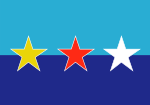 |
1970–present | Kariyushi Club (Ryukyu Independence Movement) | |
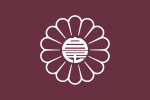 |
1955–present | Liberal Democratic Party | |
 |
1923–1942 1946–present |
Rikken Yoseikaija | |
| Former | |||
 |
2005–2013 | People's New Party | |
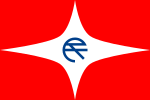 |
1960–1994 | Democratic Socialist Party | |
 |
1945–1996 | Japan Socialist Party | |
 |
1936–1944 | Tōhōkai | |
| Other | |||
 |
1936 | The Righteous Army | The four characters reading "Revere the Emperor, Destroy the Traitors" (尊皇討奸) are placed in the corners of a standard Japanese flag. |
References
[edit]- ^ "Daimyo Flags, 19th Century".
- ^ Itai Hidenobu 板井英伸 (2008). ""Naha-kō zu byōbu" ni miru 19 seiki Naha-kō no fune 『那覇港図屏風』にみる19世紀那覇港の船 (19th Century Boats in Naha Port as Depicted in the Naha Port Folding Screen)". Hikaku minzoku kenkyū 比較民俗研究 (in Japanese). 22 (22): 93–136. Retrieved June 17, 2018.










































































































































































































